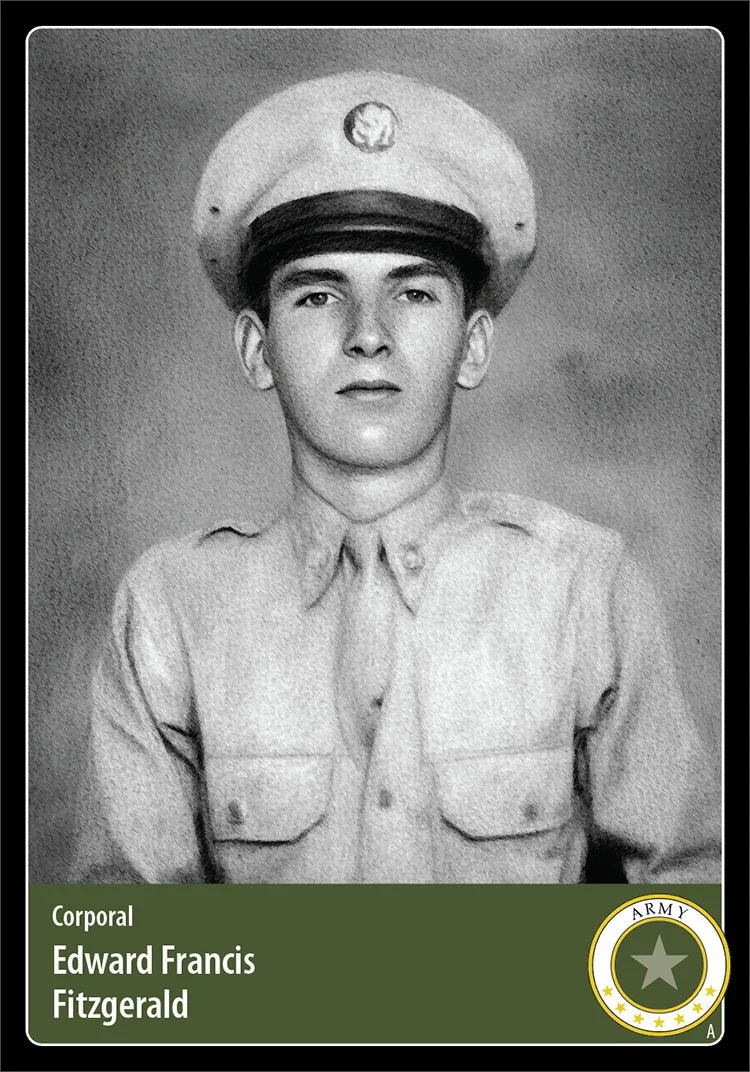Hero Card 67, Card Pack 6
Artist’s rendering by Craig Du Mez
Hometown: Syracuse, NY
Branch: U.S. Army
Unit: 34th Infantry Regiment, 24th Infantry Division
Military Honors: Prisoner of War Medal, Purple Heart
Date of Sacrifice: January 8, 1951 - Died while captured, Hanjang-ni, North Korea
Age: 24
Conflict: Korean War 1950-1953
Edward “Eddie” Francis Fitzgerald was born in Syracuse, New York, where he attended Assumption High School. Before his military service, Fitzgerald was a brakeman for the New York Central Railroad.
He joined the Army on his 22nd birthday, August 5, 1948, and traveled to Fort Bragg, North Carolina for basic training. There he was trained as a heavy weapons infantryman. Assigned to the 34th Infantry Regiment, 24th Infantry Division under the command of General William F. Dean, Fitzgerald was deployed overseas in December of 1948.
Stationed in Japan as hostilities in nearby Korea were on the brink of an explosion, the 24th Infantry Division was on standby as the United Nations prepared to prevent Communist China from seizing the Korean Peninsula.
The Korean War started officially on June 25, 1950. On July 5, Fitzgerald’s division landed at Pusan, South Korea, and moved north to stop the invading North Koreans. The 24th Infantry Division was among the first American troops sent into battle in the war.
While fighting near Taejŏn, South Korea, Eddie Fitzgerald was taken prisoner and reported missing on July 21, 1950. With early victories by the Communist Korean People’s Army (KPA), captured American prisoners were marched to northern towns that were hastily converted to prison camps.
Some 850 Americans—including 80 non-military people—were captured and marched far north in a nine-day trek to mountainous regions near the border of Siberia. Dressed for fighting in South Korea’s hot summer weather, the American soldiers were beaten and denied food and water.
The Tiger Death March
On Halloween night in 1950, the captives’ journey took another turn for the worse when KPA Major Chong Myong Sil was placed in charge of the march. Nicknamed “The Tiger” because of his relentless cruelty, the journey north came to be known as The Tiger Death March.
“The Tiger was a madman who enjoyed killing,” said James Hunt, one of the survivors. “During the march there was no food, and the only water was what snow one could manage to scoop off the ground, without being caught by one of the guards, for even this meant death. By the time we had reached the [end of the] death march on November 8, we had lost 83 POWs and one nun,” he wrote. “These included 46 murdered by the Tiger and 38 who had died from malnutrition, too weak to carry on or freezing to death.”
Those who won the battle to survive were moved between three Communist-controlled towns in North Korea. Life in one of the prison camps at Hanjang-ni is described by survivor John Powers:
“Temperatures dropped as low as 40 below at night. No fires were allowed during daylight hours. The guards were concerned smoke would attract the attention of U.S. aircraft. The prisoners constantly tried to hide any signs of illness from the guards so they would not be sent to the hospital. Almost all those sent to these ‘hospitals’ died there.”
Among those lost at Hanjang-ni prison was Cpl. Edward Francis Fitzgerald, who reportedly died of pneumonia and malnutrition on January 8, 1951, at the age of 24. Cpl. Fitzgerald’s body was recovered and returned home to Syracuse, NY in September of 1955.
He is honored at the Korean War Veterans Memorial’s Wall of Remembrance in Washington D.C.
Sources
Artist’s rendering by Craig Du Mez
Details submitted by Shawna Lawrence, Cpl. Fitzgerald’s niece
Korean War Project: CPL Edward Francis Fitzgerald
Honor States: Edward Francis Fitzgerald
The Post-Standard (Syracuse, New York): Corp. Fitzgerald Dies in Red Korea Prison Compound
The 24th Infantry Division Association: The Tiger Survivors Story—Capture and Beyond
USA Today: As POW, Native American survived torturous Tiger Death March
Korean War Ex-POW: John N. Powers—Apex Camps
Burial Site: Find a Grave





